Marc Tyler Nobleman's Blog, page 131
April 25, 2012
Superman = Springsteen, Batman = Bon Jovi?
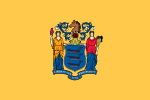
Bruce Springsteen’s kids went there. Bon Jovi’s kids, too.
And now that I've spoken at Rumson Country Day School in Rumson, NJ, the students there have been exposed to two other pop culture legends (albeit from a different field): the creators of Superman and Batman.
In a way, Superman = Springsteen and Batman = Bon Jovi. And I’m not just talking about the first letters. Springsteen is the square-jawed, broad-chested champion of the everyday person. Bon Jovi is a bit “edgier”—or he was in the 1980s, at least in comparison to Springsteen.
Even though the lyrics are darker than many realize, the title of “Born in the U.S.A.” feels more Superman. (Even though he was born on Krypton, he seems more American than Batman.) And it seems that you’d sooner catch Batman singing “Bad Medicine” or “Wanted Dead or Alive.”
Then again, Springsteen seems more taciturn, more mysterious—that’s Batman. And the Bon Jovi of today is more smiley—that’s Superman.
While we're on the subject, some postulate that Batman's Gotham City is in New Jersey...
Okay, back to Rumson!
They welcomed me with a dynamic display and one unlike any other I’ve seen: Superman smashing through a wall made of student-decorated Superman bookmarks.
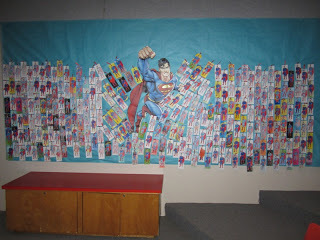
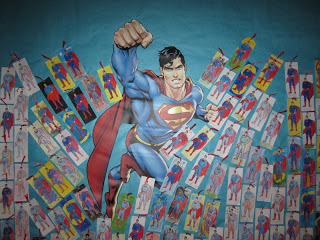
It seemed like half the books I signed were to a "Caroline" or "Jack":
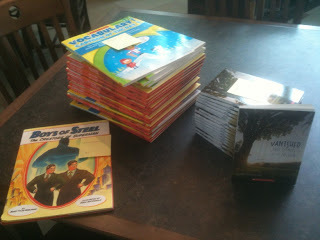
RCDS is an example of how referrals are worthwhile. In January, I spoke at Stonehouse Elementary in Williamsburg, VA.
The librarian formerly worked at RCDS and said they bring in authors, which prompted me to contact RCDS, and one kind word led to another, and a booking. Thank you all!
After, to complete the comic-book-themed day, I went to what might be one of the most famous comic book shops in America, Jay and Silent Bob's Secret Stash, owned by maverick filmmaker and comic book writer Kevin Smith:
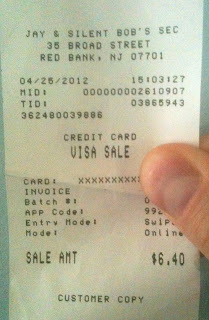
Student question of the visit: “Did any of your childhood friends also become authors?”
Published on April 25, 2012 15:11
April 24, 2012
Nonfiction = smarties
"Results from the National Assessment of Educational Progress (NAEP) show that students who receive more non-fiction instruction have higher levels of literacy."
—Moss, B. & Newton, E. 'An Examination of the Informational Text Genre in Basal Readers.' Reading Psychology, 2002.
"Children in New York City who learned to read using an experimental curriculum that emphasized nonfiction texts outperformed those at other schools..."
—"Nonfiction Curriculum Enhanced Reading Skills, Study Finds," New York Times, 3/11/12
From the same article:

—Moss, B. & Newton, E. 'An Examination of the Informational Text Genre in Basal Readers.' Reading Psychology, 2002.
"Children in New York City who learned to read using an experimental curriculum that emphasized nonfiction texts outperformed those at other schools..."
—"Nonfiction Curriculum Enhanced Reading Skills, Study Finds," New York Times, 3/11/12
From the same article:
Reading nonfiction writing is the key component of the Core Knowledge curriculum, which is based on the theory that children raised reading storybooks will lack the necessary background and vocabulary to understand history and science texts. While the curriculum allows children to read fiction, it also calls on them to knowledgeably discuss weather patterns, the solar system, and how ancient Egypt and Mesopotamia compare.
The curriculum may have a particular appeal for city schools beginning to adopt the Common Core standards, which emphasize nonfiction reading and will go into effect in 2014.
Published on April 24, 2012 04:13
April 23, 2012
I thought Pennsylvania's steel town was Pittsburgh...
...yet my friend recently spotted Boys of Steel: The Creators of Superman in Philadelphia, at the National Museum of American Jewish History.
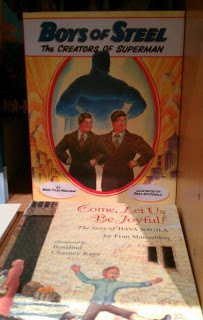
That "Hava Nagila" book looks fascinating.

That "Hava Nagila" book looks fascinating.
Published on April 23, 2012 06:03
April 22, 2012
Phase out this phrase
There is a phrase that I wish would cease to appear in picture books. (Okay, there are two. One is “There is…”)
The other phrase is so common that it probably goes unnoticed by most readers.
That phrase is “Then it happened” (or variations of it, such as “That’s when it happened,” etc.).
Even some otherwise charming books employ the phrase. Here are examples from Hunter's Big Sister by Laura Malone Elliott and The Only Boy in Ballet Class by my old friend Denise Gruska (this is The Only Phrase in the Book I'm critiquing, Denise!):
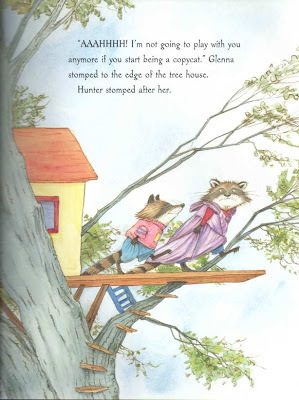
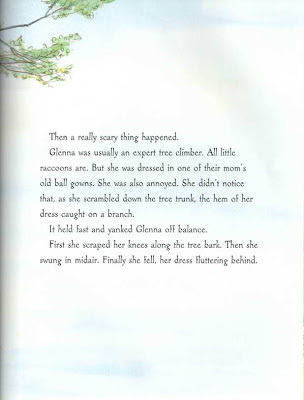
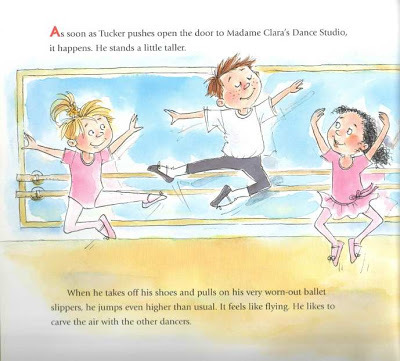 I know I've encountered other instances but they're not coming to mind; as I come across them, I will revisit this post to insert them.
I know I've encountered other instances but they're not coming to mind; as I come across them, I will revisit this post to insert them.
I understand why the phrase is used. When a story contains a sudden shift in action, a writer feels he must set that up. Summoning a “then it happened” comes so naturally, it’s practically punctuation.
But I feel it is a weak segue, a hollow way to propel the reader to an exciting event in the next sentence. Why not just get to the good part?
“There is” (and its variations, such as “There are”) can always and easily be rewritten in a stronger way: “There is a baby duck waddling around on my front step” is more muscular as “A baby duck is waddling around on my front step.”
Similarly, “then it happened” can always be rewritten or often simply removed; as proof, reread the above passages but leave out the phrase. Missing anything? I don't think you will.
I feel writers have an obligation to entice readers not with familiar (and therefore empty) phrases but with original expressions that convey excitement through concrete action.
This concludes today’s Nitpicking 101 lesson. Your homework: post something nitpick-y about one of my books. Education never dies.

The other phrase is so common that it probably goes unnoticed by most readers.
That phrase is “Then it happened” (or variations of it, such as “That’s when it happened,” etc.).
Even some otherwise charming books employ the phrase. Here are examples from Hunter's Big Sister by Laura Malone Elliott and The Only Boy in Ballet Class by my old friend Denise Gruska (this is The Only Phrase in the Book I'm critiquing, Denise!):


 I know I've encountered other instances but they're not coming to mind; as I come across them, I will revisit this post to insert them.
I know I've encountered other instances but they're not coming to mind; as I come across them, I will revisit this post to insert them.I understand why the phrase is used. When a story contains a sudden shift in action, a writer feels he must set that up. Summoning a “then it happened” comes so naturally, it’s practically punctuation.
But I feel it is a weak segue, a hollow way to propel the reader to an exciting event in the next sentence. Why not just get to the good part?
“There is” (and its variations, such as “There are”) can always and easily be rewritten in a stronger way: “There is a baby duck waddling around on my front step” is more muscular as “A baby duck is waddling around on my front step.”
Similarly, “then it happened” can always be rewritten or often simply removed; as proof, reread the above passages but leave out the phrase. Missing anything? I don't think you will.
I feel writers have an obligation to entice readers not with familiar (and therefore empty) phrases but with original expressions that convey excitement through concrete action.
This concludes today’s Nitpicking 101 lesson. Your homework: post something nitpick-y about one of my books. Education never dies.
Published on April 22, 2012 04:37
April 20, 2012
A preview of "Previews"
Bill the Boy Wonder: The Secret Co-Creator of Batman is a Featured Item in the May 2012 Previews, the catalog of upcoming releases distributed in comics shops nationwide. Previews goes on sale the last Wednesday in April but you saw it here first:
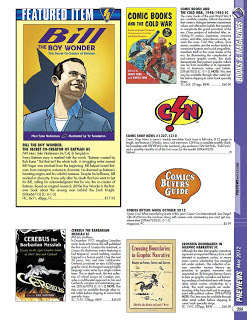
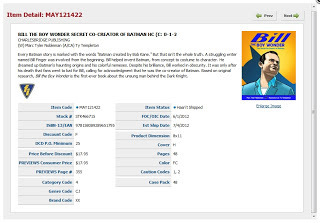



Published on April 20, 2012 04:00
April 19, 2012
Undercover author
The 2/22/12 New York Times exposed author Kate Alcott’s secret identity.
She is really author Patricia O’Brien.
See, O’Brien was shopping around her sixth novel (and ninth book overall). Her longtime Simon & Schuster editor, among 12 others, turned it down.
The reason? Hazard a guess:
a) limp prose
b) unoriginal plot
c) her last novel didn’t sell enough
d) O’Brien is a raving wacknut
The answer is c), for “come on.”
But that is largely the state of publishing today—publishers pressured to go for saleability over originality, lyricism, or other merit.
So O’Brien went and proved this thinking shortsighted. And to do so, she took what I perceive to be a big risk, one that could have sabotaged her credibility (and one that reminds me of an experiment I did to try to sell a nonfiction picture book I wrote about a little-known WWII incident involving a Japanese pilot).
She resolicited the manuscript under a pen name, Kate Alcott.
And it sold in three days.
Read the rest of what I feel is an important story here.
She is really author Patricia O’Brien.
See, O’Brien was shopping around her sixth novel (and ninth book overall). Her longtime Simon & Schuster editor, among 12 others, turned it down.
The reason? Hazard a guess:
a) limp prose
b) unoriginal plot
c) her last novel didn’t sell enough
d) O’Brien is a raving wacknut
The answer is c), for “come on.”
But that is largely the state of publishing today—publishers pressured to go for saleability over originality, lyricism, or other merit.
So O’Brien went and proved this thinking shortsighted. And to do so, she took what I perceive to be a big risk, one that could have sabotaged her credibility (and one that reminds me of an experiment I did to try to sell a nonfiction picture book I wrote about a little-known WWII incident involving a Japanese pilot).
She resolicited the manuscript under a pen name, Kate Alcott.
And it sold in three days.
Read the rest of what I feel is an important story here.
Published on April 19, 2012 04:26
April 18, 2012
A Beethoven-Justin Bieber duet
In between my presentations at a Georgia school, the librarians were admitting frustration when kids ask for books about famous entertainers or sports stars of the moment. Some school and library market publishers produce such lightweight biographies because those books might attract a student who is otherwise not a motivated reader. And most anyone in education would rather a young person read a celeb bio than nothing.
However, I understand their frustration when, in the very same room, there is so much actual literature—including biographies of people whose accomplishments are more significant, not to mention time-tested—to choose from.
I was struck with an idea. What about creating two-in-one biographies, one on a contemporary figure and one historic—perhaps both from a similar field? In a music-themed title, one half of the book could be about Beethoven and the other Justin Bieber. Kids who pick up the book for Bieber may stick around for Beethoven.
But it may be even more effective to avoid themes; in some cases, themes would be too limiting. Who from pop culture, for example, could be paired with Joan of Arc?
Completely random pairings might seem bizarre at first, but would likely have the biggest payoff:
Rosa Parks and Ryan SeacrestClara Barton and Taylor SwiftHarriet Tubman and Chris ColferMatthew Henson and Suzanne CollinsThomas Jefferson and Shaun WhiteJackie Robinson and Chlöe Grace MoretzAlexander the Great and Jennifer HudsonNelson Mandela and Eric Stonestreet
Creating profoundly unlikely team-ups is huge fun. Try it!
This proposal echoes a strategy some parents employ when trying to expand kids’ food repertoires: sticking both a noodle and, say, a piece of broccoli on the fork at the same time—noodle first. To get to the noodle, the young person has to go through the broccoli—and hopefully s/he will find that s/he enjoyed doing it.
4/20/12 addendum: See first two comments below for an elaboration on this last paragraph; in short, I am not equating the “serious” figure with broccoli in a negative way; rather I am trying to show that both the serious figure and the broccoli are worth getting to, even if by a bit of trickery! I’m trying to break their respective stigmas.
However, I understand their frustration when, in the very same room, there is so much actual literature—including biographies of people whose accomplishments are more significant, not to mention time-tested—to choose from.
I was struck with an idea. What about creating two-in-one biographies, one on a contemporary figure and one historic—perhaps both from a similar field? In a music-themed title, one half of the book could be about Beethoven and the other Justin Bieber. Kids who pick up the book for Bieber may stick around for Beethoven.
But it may be even more effective to avoid themes; in some cases, themes would be too limiting. Who from pop culture, for example, could be paired with Joan of Arc?
Completely random pairings might seem bizarre at first, but would likely have the biggest payoff:
Rosa Parks and Ryan SeacrestClara Barton and Taylor SwiftHarriet Tubman and Chris ColferMatthew Henson and Suzanne CollinsThomas Jefferson and Shaun WhiteJackie Robinson and Chlöe Grace MoretzAlexander the Great and Jennifer HudsonNelson Mandela and Eric Stonestreet
Creating profoundly unlikely team-ups is huge fun. Try it!
This proposal echoes a strategy some parents employ when trying to expand kids’ food repertoires: sticking both a noodle and, say, a piece of broccoli on the fork at the same time—noodle first. To get to the noodle, the young person has to go through the broccoli—and hopefully s/he will find that s/he enjoyed doing it.
4/20/12 addendum: See first two comments below for an elaboration on this last paragraph; in short, I am not equating the “serious” figure with broccoli in a negative way; rather I am trying to show that both the serious figure and the broccoli are worth getting to, even if by a bit of trickery! I’m trying to break their respective stigmas.
Published on April 18, 2012 04:23
April 17, 2012
Back-to-back talks: synagogue and library
On 4/15/12, I spoke at Congregation Beth El, a synagogue in Bethesda, MD, from 10 to 11:15 a.m. and Chinn Park Regional Library in Woodbridge, VA, from 2:15 to 3 p.m.
At Beth El, during the Q&A, a woman asked if my “spit curl” was in honor of Superman’s.
Mine:
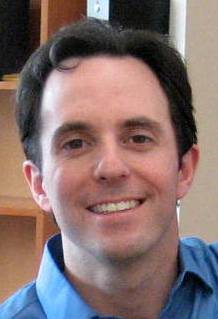
Superman’s:
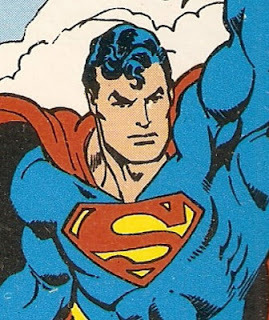
I said no, though it would be a sight if I could somehow position what I hadn’t realized was a spit curl into the shape of an N…
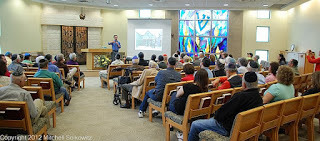
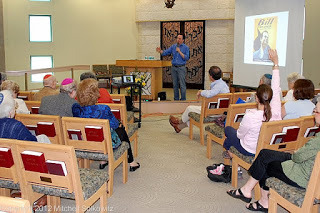
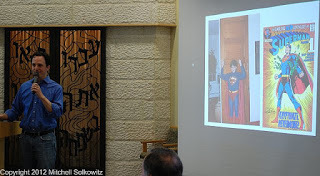
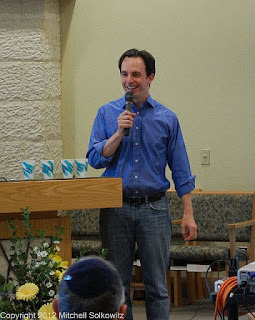
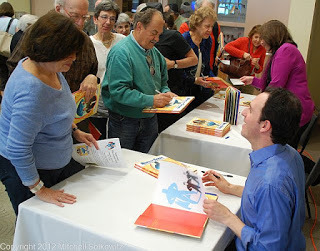
Special thanks to and photographs above © Mitchell Solkowitz.
When I left for Chinn Park, the GPS said I’d arrive at 1:43 p.m. Due to unforeseen traffic on both the original and detour routes, I did not arrive until 2:15 p.m. Of course I called from the car to alert them to the situation, and also turned on my laptop and queued up the presentation start slide so I could run in with the netbook, plug it in, and go. (Of course I fiddled with the laptop only when stopped in traffic—which was most of the trip.)
In the final minutes before my arrival, sporting gritted teeth, I’d prepared an opening apology line: “Superheroes always arrive in the nick of time. Now we know that authors, unfortunately, do not.” But once I saw that the turnout was much bigger than I was expecting, I debated changing my line to this: “Now I know why I was late. I’m assuming all of you were the traffic that was in front of me.”
In fact, this was possibly the biggest turnout I’ve ever had at a library—standing room only, and not a small room. I was heartened that the audience hadn’t bailed because I was late—or because it was a gorgeous Sunday afternoon. When I finally did get there, a few kind souls told me before I began speaking that such traffic is a regular occurrence in that particular corridor. It did make me feel better.
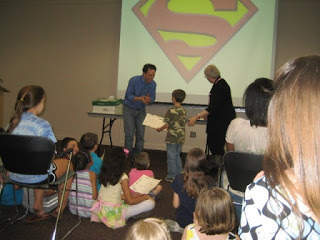
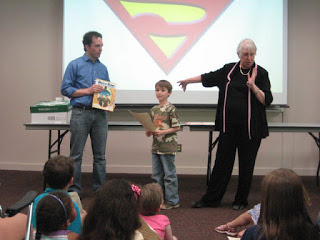
Two previous photos courtesy of KimSu Beauregard
Among the many kind people I was fortunate to meet at the library was a precious first grader who has been battling (and kicking the tail of) leukemia. She was a hug magnet. Another was the voice of Joker’s girlfriend Harley Quinn for DC Comics audio books.
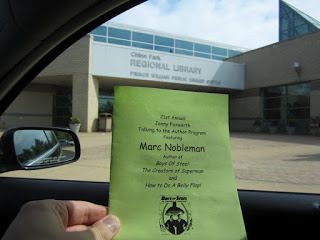
Traffic going home, mercifully, was easy like Sunday afternoon.
At Beth El, during the Q&A, a woman asked if my “spit curl” was in honor of Superman’s.
Mine:

Superman’s:

I said no, though it would be a sight if I could somehow position what I hadn’t realized was a spit curl into the shape of an N…





Special thanks to and photographs above © Mitchell Solkowitz.
When I left for Chinn Park, the GPS said I’d arrive at 1:43 p.m. Due to unforeseen traffic on both the original and detour routes, I did not arrive until 2:15 p.m. Of course I called from the car to alert them to the situation, and also turned on my laptop and queued up the presentation start slide so I could run in with the netbook, plug it in, and go. (Of course I fiddled with the laptop only when stopped in traffic—which was most of the trip.)
In the final minutes before my arrival, sporting gritted teeth, I’d prepared an opening apology line: “Superheroes always arrive in the nick of time. Now we know that authors, unfortunately, do not.” But once I saw that the turnout was much bigger than I was expecting, I debated changing my line to this: “Now I know why I was late. I’m assuming all of you were the traffic that was in front of me.”
In fact, this was possibly the biggest turnout I’ve ever had at a library—standing room only, and not a small room. I was heartened that the audience hadn’t bailed because I was late—or because it was a gorgeous Sunday afternoon. When I finally did get there, a few kind souls told me before I began speaking that such traffic is a regular occurrence in that particular corridor. It did make me feel better.


Two previous photos courtesy of KimSu Beauregard
Among the many kind people I was fortunate to meet at the library was a precious first grader who has been battling (and kicking the tail of) leukemia. She was a hug magnet. Another was the voice of Joker’s girlfriend Harley Quinn for DC Comics audio books.

Traffic going home, mercifully, was easy like Sunday afternoon.
Published on April 17, 2012 04:00
April 16, 2012
The Batman of 1932
Smarticulate Massachusetts man Frank D. Foster III believes Bob Kane and/or Bill Finger may have stolen the idea for Batman from his father (who passed away in 1995). Yes, Foster II created a hero whom he named Batman in 1932—seven years before the Batman you know first appeared.
Here he is:
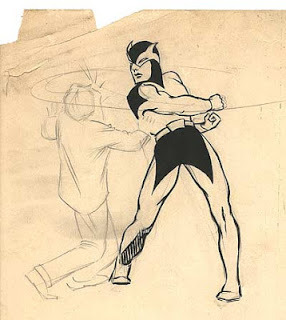
Foster II (hereafter referred to simply as “Foster”) shopped his Batman around to publishers, but got no takers. Foster III (hereafter referred to as “Frank”) feels it is not a coincidence that Finger and Kane’s Batman came out later that decade.
I love Frank’s conviction, and his intriguing claim is certainly worthy of investigation, but for many reasons (all of which I’ve detailed for Frank), I’m convinced that his father’s character had nothing to do with the Finger/Kane Batman.
I think it is highly unlikely that Foster crossed paths with Kane and Finger, at least not with regard to Foster’s drawings. Both Finger and Kane were in high school in 1932. Finger was not involved with comics till 1938. Writers/artists were not necessarily hanging around the publishers' offices, decreasing chances of such an encounter. It’s virtually impossible that Finger in particular could’ve seen Foster’s drawings—upon Batman’s debut in 1939, Finger was an anonymous work-for-hire Kane writer that even the publisher of Batman wouldn’t know about for at least another year.
When Foster created his character in 1932, the first “official” comic book was still three years away. A publisher that passed on a submission in 1932 would almost certainly not save it till 1939—they barely saved art of comics they actually published.
Comparing dates of creation is not conclusive of theft; multiple people have similar ideas all the time. Even if Frank were to prove that his father did submit the character to a company that Kane or Finger had an association with at some point would not be conclusive by a long shot.
Every character is a distillation of characters that have come before; Batman had elements of Zorro, who had elements of the Scarlet Pimpernel, who had elements of Robin Hood...and so on back. It’s hard to argue that any one character is “unique.” At the time, numerous characters in movies and pulps already had a bat motif—Finger and Kane openly cited as one of their influences a 1930 movie called The Bat Whispers. Other people we may never know about might also have created a character called Batman pre-1939!
The bat motif was not the only trait of Foster’s character with precedent—earlier crime fighters were also non-powered and/or associated with the night, such as Zorro and the Shadow (debuted 1930), plus others who debuted later in the 1930s including the Phantom and the Crimson Avenger. The resemblance between Foster’s character and Kane/Finger's is not striking enough, in my opinion—lots of characters had masks of various kinds.
It is interesting that Foster named other ultimately unpublished characters Nightwing and Raven; DC's Nightwing and Raven did not come till the 1980s, so there was almost certainly no correlation. It’s hardly even a coincidence. Just about every animal besides the donkey has been the name of a character at one point, so Raven is not surprising; as for Nightwing, take a look at this partial list of Golden Age character names. The same words were used over and over in slightly different ways. Names alone don't mean much, which is why you can't copyright them.
Finger freely admitted that the idea to make Batman’s eyes mere slits came from the Phantom, so if the influence had been another source instead, I suspect he would have just as easily admitted that.
It is well-documented that Kane swiped other artists’ poses, so if he had seen Foster’s drawings, why didn’t he use those elements in his (Kane’s) first drawing of Batman? Besides, both Kane and Finger said the key costume elements came from Finger. And again, if Kane had been the one to come up with the look, he would have shouted it from the rooftops. (He took credit for plenty he didn’t do, so he most assuredly took credit for what little he did do.)
I am not usually one to defend Kane, but the timeline and logistics just don’t add up. Kane was a pirate—just not in this instance.
I accept the authenticity of Foster’s drawings. I accept that they came before Kane/Finger’s character. I even accept the possibility that Kane or Finger somehow saw Foster’s drawings somewhere along the way. However, as noted above, I feel the chance of that is slimmer than Batman’s eye slits.
So without written, contemporaneous proof, I believe this was a simple case of multiple creative young men hatching a marginally similar idea in the same city within a few years of each other. Happens all the time. Happening right now, somewhere. That does not, however, increase the likelihood that there was any impropriety over intellectual property.
From an aesthetic and historic perspective, I am glad Frank has shared his father’s work with the world. It is fascinating in its own right.
Here he is:

Foster II (hereafter referred to simply as “Foster”) shopped his Batman around to publishers, but got no takers. Foster III (hereafter referred to as “Frank”) feels it is not a coincidence that Finger and Kane’s Batman came out later that decade.
I love Frank’s conviction, and his intriguing claim is certainly worthy of investigation, but for many reasons (all of which I’ve detailed for Frank), I’m convinced that his father’s character had nothing to do with the Finger/Kane Batman.
I think it is highly unlikely that Foster crossed paths with Kane and Finger, at least not with regard to Foster’s drawings. Both Finger and Kane were in high school in 1932. Finger was not involved with comics till 1938. Writers/artists were not necessarily hanging around the publishers' offices, decreasing chances of such an encounter. It’s virtually impossible that Finger in particular could’ve seen Foster’s drawings—upon Batman’s debut in 1939, Finger was an anonymous work-for-hire Kane writer that even the publisher of Batman wouldn’t know about for at least another year.
When Foster created his character in 1932, the first “official” comic book was still three years away. A publisher that passed on a submission in 1932 would almost certainly not save it till 1939—they barely saved art of comics they actually published.
Comparing dates of creation is not conclusive of theft; multiple people have similar ideas all the time. Even if Frank were to prove that his father did submit the character to a company that Kane or Finger had an association with at some point would not be conclusive by a long shot.
Every character is a distillation of characters that have come before; Batman had elements of Zorro, who had elements of the Scarlet Pimpernel, who had elements of Robin Hood...and so on back. It’s hard to argue that any one character is “unique.” At the time, numerous characters in movies and pulps already had a bat motif—Finger and Kane openly cited as one of their influences a 1930 movie called The Bat Whispers. Other people we may never know about might also have created a character called Batman pre-1939!
The bat motif was not the only trait of Foster’s character with precedent—earlier crime fighters were also non-powered and/or associated with the night, such as Zorro and the Shadow (debuted 1930), plus others who debuted later in the 1930s including the Phantom and the Crimson Avenger. The resemblance between Foster’s character and Kane/Finger's is not striking enough, in my opinion—lots of characters had masks of various kinds.
It is interesting that Foster named other ultimately unpublished characters Nightwing and Raven; DC's Nightwing and Raven did not come till the 1980s, so there was almost certainly no correlation. It’s hardly even a coincidence. Just about every animal besides the donkey has been the name of a character at one point, so Raven is not surprising; as for Nightwing, take a look at this partial list of Golden Age character names. The same words were used over and over in slightly different ways. Names alone don't mean much, which is why you can't copyright them.
Finger freely admitted that the idea to make Batman’s eyes mere slits came from the Phantom, so if the influence had been another source instead, I suspect he would have just as easily admitted that.
It is well-documented that Kane swiped other artists’ poses, so if he had seen Foster’s drawings, why didn’t he use those elements in his (Kane’s) first drawing of Batman? Besides, both Kane and Finger said the key costume elements came from Finger. And again, if Kane had been the one to come up with the look, he would have shouted it from the rooftops. (He took credit for plenty he didn’t do, so he most assuredly took credit for what little he did do.)
I am not usually one to defend Kane, but the timeline and logistics just don’t add up. Kane was a pirate—just not in this instance.
I accept the authenticity of Foster’s drawings. I accept that they came before Kane/Finger’s character. I even accept the possibility that Kane or Finger somehow saw Foster’s drawings somewhere along the way. However, as noted above, I feel the chance of that is slimmer than Batman’s eye slits.
So without written, contemporaneous proof, I believe this was a simple case of multiple creative young men hatching a marginally similar idea in the same city within a few years of each other. Happens all the time. Happening right now, somewhere. That does not, however, increase the likelihood that there was any impropriety over intellectual property.
From an aesthetic and historic perspective, I am glad Frank has shared his father’s work with the world. It is fascinating in its own right.
Published on April 16, 2012 04:00
April 15, 2012
Martha's Vineyard Children's Book Festival
Like to read? Shore you do!
The first annual
Martha’s Vineyard
Children’s Book Festival
It will give new meaning to “beach reading.”
20 award-winning, untanned authors and illustrators
6 schools
1 billion grains of sand
1 historic day…
THE CO-SPONSORS:
Local Bookstore(s)
Corporate Contributor(s) *
and/or
Generous Patron(s)
THE AUTHORS AND ILLUSTRATORS:
TBD. But awesome ones.
THE SCHEDULE:
Chapter 1—School Visit Round Robin
What it is: three back-to-back author presentations per school:
8:30 a.m. author 1
10:00 a.m. author 2
11:30 p.m. author 3
12:45 p.m. lunch with authors (perhaps a select group of writing-focused students who applied/were chosen in advance)
Chapter 2—Beach Book Bonanza
What it is: an open-to-the-public afternoon of book-themed fun on the beach, including continuous book signings and the following activities (with more possibilities below at **):
2:00 p.m. sand character building contest (forget sand castles—kids make a sand sculpture of their favorite children’s book character; authors are judges)
3:00 p.m. kids vs. authors beach volleyball
4:00 p.m. aerial photograph (kids positioned to spell out “I’m Needing Beach Reading” or similar)
Prizes for all winners (hint: prizes are not waterproof).
Advanced sign-up and parent on site required for all beach events.
Other spectators encouraged!
In event of rain, alternate yet equally fun activities and indoor location to be announced.
Chapter 3—Sunset Panels and Performances
What it is: family picnic on the beach while listening to humorous, helpful, and unpredictable author panel discussions moderated by Local Celeb TBD, followed by an unprecedented, all-author variety show:
5:30 p.m. author panel 1
6:00 p.m. author panel 2
6:30 p.m. author panel 3
Panels can be themed or random. Themes can be straightforward (Funny Picture Books, Real Life Thrills, Debut Authors) or silly (Bald or Balding Authors, Do Talking Animals Need Clothes?, Books in Space).
7:00 p.m. “America’s Got Authors”—the authors team up and perform skits and songs based on their books; warning: audience volunteers may be called on at random!
8:30 p.m. book signings
9:30 p.m. tuck authors in
THE DIFFERENCE:
What makes this book festival one-of-a-kind?
first-ever children’s book festival on Martha’s Vineyardpossibly first-ever book festival on a beach?co-created by authors who have been to multiple festivals nationwide and have seen what works and what doesn’t authors sign and speak as usual, but also have a more interactive role throughout the day—including opportunities to step outside their author rolesdiverse schedule includes both enrichment for every public school on the island and programming for the publicunconventional events such as kids vs. authors volleyball and author variety show likely to attract mainstream press
THE REST:
* among the corporate sponsors to pursue:
Six Flags (they run a summer reading campaign)
Vineyard Vines
Whole Foods
Stonyfield Farm
Ben & Jerry’s (maybe they’d even make a special flavor for the occasion such as Kidlit Choclit or Bookberry Muffin, only far more clever)
Melissa & Doug
New England Patriots
Boston Red Sox
Read Kiddo Read
Nickelodeon
Scholastic
Blackboard
Life Is Good
Bright Horizons
Staples
BJ's Wholesale Club
Cape Cod Chips
Children’s Hospital Boston
Stride Rite
New Balance
Edutopia (a George Lucas company)
Domtar
other literacy-minded companies, particularly ones based in MA
** other possible activities:
summer snowball fight (would require storing snowballs from winter in freezers and bringing them to beach in coolers; takes effort but huge payoff)kids vs. authors tug of peaceprint books vs. e-books reading racedunk an author booth (for charity?)shoreline scavenger hunt (find items related to the authors’ books)summer-themed quiz bowl on children’s booksget photo taken in scenes from favorite books (those painted lifesized scenes with a hole where you stick your face); or maybe kids can design and paint their own?something green, i.e. cleaning up a beach, but must also relate to books somehow
If you are a possible Corporate Contributor or Generous Patron who wants to be part of the next generation of book festivals, I look forward to hearing from you.
The first annual
Martha’s Vineyard
Children’s Book Festival
It will give new meaning to “beach reading.”
20 award-winning, untanned authors and illustrators
6 schools
1 billion grains of sand
1 historic day…
THE CO-SPONSORS:
Local Bookstore(s)
Corporate Contributor(s) *
and/or
Generous Patron(s)
THE AUTHORS AND ILLUSTRATORS:
TBD. But awesome ones.
THE SCHEDULE:
Chapter 1—School Visit Round Robin
What it is: three back-to-back author presentations per school:
8:30 a.m. author 1
10:00 a.m. author 2
11:30 p.m. author 3
12:45 p.m. lunch with authors (perhaps a select group of writing-focused students who applied/were chosen in advance)
Chapter 2—Beach Book Bonanza
What it is: an open-to-the-public afternoon of book-themed fun on the beach, including continuous book signings and the following activities (with more possibilities below at **):
2:00 p.m. sand character building contest (forget sand castles—kids make a sand sculpture of their favorite children’s book character; authors are judges)
3:00 p.m. kids vs. authors beach volleyball
4:00 p.m. aerial photograph (kids positioned to spell out “I’m Needing Beach Reading” or similar)
Prizes for all winners (hint: prizes are not waterproof).
Advanced sign-up and parent on site required for all beach events.
Other spectators encouraged!
In event of rain, alternate yet equally fun activities and indoor location to be announced.
Chapter 3—Sunset Panels and Performances
What it is: family picnic on the beach while listening to humorous, helpful, and unpredictable author panel discussions moderated by Local Celeb TBD, followed by an unprecedented, all-author variety show:
5:30 p.m. author panel 1
6:00 p.m. author panel 2
6:30 p.m. author panel 3
Panels can be themed or random. Themes can be straightforward (Funny Picture Books, Real Life Thrills, Debut Authors) or silly (Bald or Balding Authors, Do Talking Animals Need Clothes?, Books in Space).
7:00 p.m. “America’s Got Authors”—the authors team up and perform skits and songs based on their books; warning: audience volunteers may be called on at random!
8:30 p.m. book signings
9:30 p.m. tuck authors in
THE DIFFERENCE:
What makes this book festival one-of-a-kind?
first-ever children’s book festival on Martha’s Vineyardpossibly first-ever book festival on a beach?co-created by authors who have been to multiple festivals nationwide and have seen what works and what doesn’t authors sign and speak as usual, but also have a more interactive role throughout the day—including opportunities to step outside their author rolesdiverse schedule includes both enrichment for every public school on the island and programming for the publicunconventional events such as kids vs. authors volleyball and author variety show likely to attract mainstream press
THE REST:
* among the corporate sponsors to pursue:
Six Flags (they run a summer reading campaign)
Vineyard Vines
Whole Foods
Stonyfield Farm
Ben & Jerry’s (maybe they’d even make a special flavor for the occasion such as Kidlit Choclit or Bookberry Muffin, only far more clever)
Melissa & Doug
New England Patriots
Boston Red Sox
Read Kiddo Read
Nickelodeon
Scholastic
Blackboard
Life Is Good
Bright Horizons
Staples
BJ's Wholesale Club
Cape Cod Chips
Children’s Hospital Boston
Stride Rite
New Balance
Edutopia (a George Lucas company)
Domtar
other literacy-minded companies, particularly ones based in MA
** other possible activities:
summer snowball fight (would require storing snowballs from winter in freezers and bringing them to beach in coolers; takes effort but huge payoff)kids vs. authors tug of peaceprint books vs. e-books reading racedunk an author booth (for charity?)shoreline scavenger hunt (find items related to the authors’ books)summer-themed quiz bowl on children’s booksget photo taken in scenes from favorite books (those painted lifesized scenes with a hole where you stick your face); or maybe kids can design and paint their own?something green, i.e. cleaning up a beach, but must also relate to books somehow
If you are a possible Corporate Contributor or Generous Patron who wants to be part of the next generation of book festivals, I look forward to hearing from you.
Published on April 15, 2012 04:08



